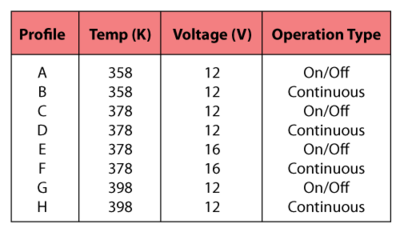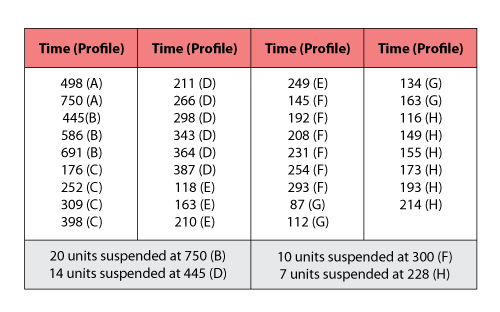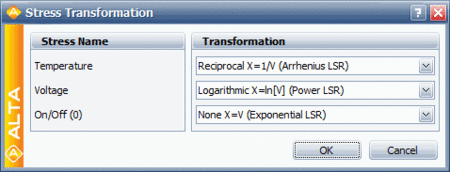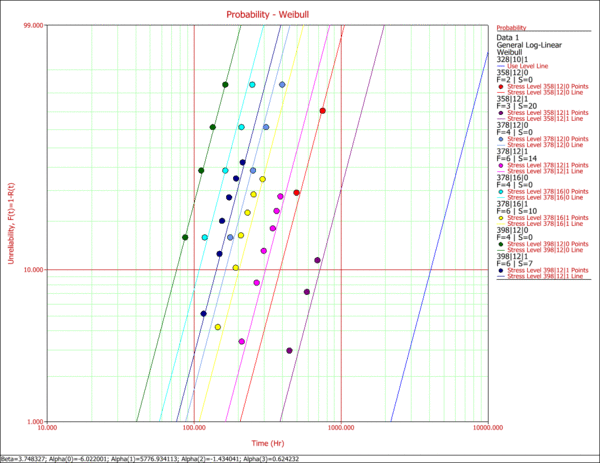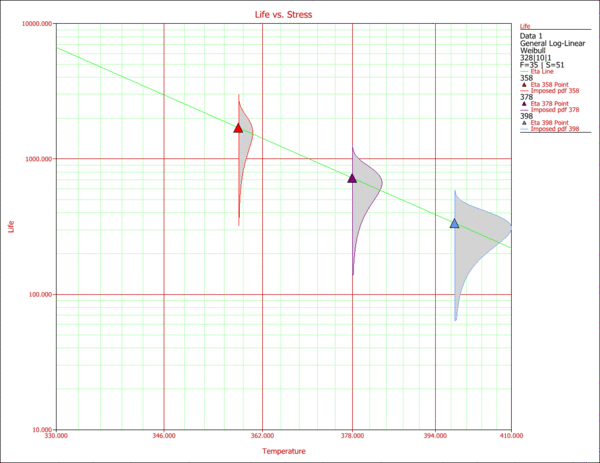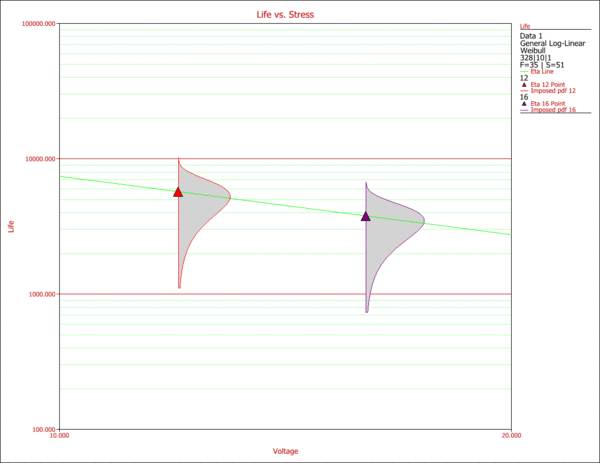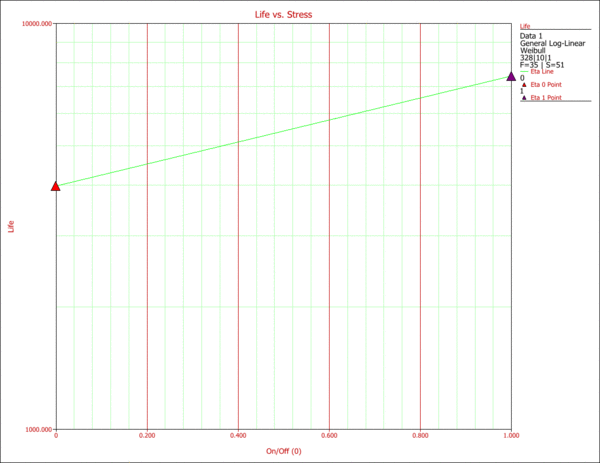ALTA ALTA Standard Folio Data GLL-Exponential
|
Reliability Web Notes | |||||||||
|---|---|---|---|---|---|---|---|---|---|
| Standard Folio Data GLL-Exponential | |||||||||
| ALTA | |||||||||
|
So far in this reference the life-stress relationships presented have been either single stress relationships or two stress relationships. In most practical applications, however, life is a function of more than one or two variables (stress types). In addition, there are many applications where the life of a product as a function of stress and of some engineering variable other than stress is sought. In this chapter, the general log-linear relationship and the proportional hazards model are presented for the analysis of such cases where more than two accelerated stresses (or variables) need to be considered.
General Log-Linear RelationshipWhen a test involves multiple accelerating stresses or requires the inclusion of an engineering variable, a general multivariable relationship is needed. Such a relationship is the general log-linear relationship, which describes a life characteristic as a function of a vector of [math]\displaystyle{ n\,\! }[/math] stresses, or [math]\displaystyle{ \underline{X}=({{X}_{1}},{{X}_{2}}...{{X}_{n}}).\,\! }[/math] ALTA includes this relationship and allows up to eight stresses. Mathematically the relationship is given by:
where:
This relationship can be further modified through the use of transformations and can be reduced to the relationships discussed previously, if so desired. As an example, consider a single stress application of this relationship and an inverse transformation on [math]\displaystyle{ X,\,\! }[/math] such that [math]\displaystyle{ V=1/X\,\! }[/math] or:
It can be easily seen that the generalized log-linear relationship with a single stress and an inverse transformation has been reduced to the Arrhenius relationship, where:
or:
Similarly, when one chooses to apply a logarithmic transformation on [math]\displaystyle{ X\,\! }[/math] such that [math]\displaystyle{ X=\ln (V)\,\! }[/math], the relationship would reduce to the Inverse Power Law relationship. Furthermore, if more than one stress is present, one could choose to apply a different transformation to each stress to create combination relationships similar to the Temperature-Humidity and the Temperature-Non Thermal. ALTA has three built-in transformation options, namely:
The power of the relationship and this formulation becomes evident once one realizes that 6,561 unique life-stress relationships are possible (when allowing a maximum of eight stresses). When combined with the life distributions available in ALTA, almost 20,000 models can be created. Using the GLL ModelLike the previous relationships, the general log-linear relationship can be combined with any of the available life distributions by expressing a life characteristic from that distribution with the GLL relationship. A brief overview of the GLL-distribution models available in ALTA is presented next. GLL ExponentialThe GLL-exponential model can be derived by setting [math]\displaystyle{ m=L(\underline{X})\,\! }[/math] in the exponential pdf, yielding the following GLL-exponential pdf: [math]\displaystyle{ f(t,\underline{X})={{e}^{-\left( {{\alpha }_{0}}+\underset{j=1}{\overset{n}{\mathop{\sum }}}\,{{\alpha }_{j}}{{X}_{j}} \right)}}{{e}^{-\left( {{\alpha }_{0}}+\underset{j=1}{\overset{n}{\mathop{\sum }}}\,{{\alpha }_{j}}{{X}_{j}} \right)\cdot t}}\,\! }[/math] The total number of unknowns to solve for in this model is [math]\displaystyle{ n+1\,\! }[/math] (i.e., [math]\displaystyle{ {{a}_{0}},{{a}_{1}},...{{a}_{n}}).\,\! }[/math] GLL WeibullThe GLL-Weibull model can be derived by setting [math]\displaystyle{ \eta =L(\underline{X})\,\! }[/math] in Weibull pdf, yielding the following GLL-Weibull pdf: [math]\displaystyle{ f(t,\underline{X})=\beta \cdot {{t}^{\beta -1}}{{e}^{-\beta \left( {{\alpha }_{0}}+\underset{j=1}{\overset{n}{\mathop{\sum }}}\,{{\alpha }_{j}}{{X}_{j}} \right)}}{{e}^{-{{t}^{\beta }}{{e}^{-\beta \left( {{\alpha }_{0}}+\underset{j=1}{\overset{n}{\mathop{\sum }}}\,{{\alpha }_{j}}{{X}_{j}} \right)}}}}\,\! }[/math] The total number of unknowns to solve for in this model is [math]\displaystyle{ n+2\,\! }[/math] (i.e., [math]\displaystyle{ \beta ,{{a}_{0}},{{a}_{1}},...{{a}_{n}}).\,\! }[/math] GLL LognormalThe GLL-lognormal model can be derived by setting [math]\displaystyle{ \breve{T}=L(\underline{X})\,\! }[/math] in the lognormal pdf, yielding the following GLL-lognormal pdf: [math]\displaystyle{ f(t,\underline{X})=\frac{1}{t\text{ }{{\sigma }_{{{T}'}}}\sqrt{2\pi }}{{e}^{-\tfrac{1}{2}{{\left( \tfrac{{T}'-{{\alpha }_{0}}-\underset{j=1}{\overset{n}{\mathop{\sum }}}\,{{\alpha }_{j}}{{X}_{j}}}{{{\sigma }_{{{T}'}}}} \right)}^{2}}}}\,\! }[/math] The total number of unknowns to solve for in this model is [math]\displaystyle{ n+2\,\! }[/math] (i.e., [math]\displaystyle{ {{\sigma }_{{{T}'}}},{{a}_{0}},{{a}_{1}},...{{a}_{n}}).\,\! }[/math] GLL Likelihood FunctionThe maximum likelihood estimation method can be used to determine the parameters for the GLL relationship and the selected life distribution. For each distribution, the likelihood function can be derived, and the parameters of model (the distribution parameters and the GLL parameters) can be obtained by maximizing the log-likelihood function. For example, the log-likelihood function for the Weibull distribution is given by:
where:
and:
GLL ExampleConsider the data summarized in the following tables. These data illustrate a typical three-stress type accelerated test.
The data in the second table are analyzed assuming a Weibull distribution, an Arrhenius life-stress relationship for temperature and an inverse power life-stress relationship for voltage. No transformation is performed on the operation type. The operation type variable is treated as an indicator variable that takes a discrete value of 0 for an on/off operation and 1 for a continuous operation. The following figure shows the stress types and their transformations in ALTA.
The GLL relationship then becomes:
The resulting relationship after performing these transformations is:
Therefore, the parameter [math]\displaystyle{ B\,\! }[/math] of the Arrhenius relationship is equal to the log-linear coefficient [math]\displaystyle{ {{\alpha }_{1}}\,\! }[/math], and the parameter [math]\displaystyle{ n\,\! }[/math] of the inverse power relationship is equal to ([math]\displaystyle{ -{{\alpha}_{2}}\,\! }[/math]). Therefore [math]\displaystyle{ \eta \,\! }[/math] can also be written as:
The activation energy of the Arrhenius relationship can be calculated by multiplying B with Boltzmann's constant. The best fit values for the parameters in this case are:
Once the parameters are estimated, further analysis on the data can be performed. First, using ALTA, a Weibull probability plot of the data can be obtained, as shown next.
Proportional Hazards ModelIntroduced by D. R. Cox, the Proportional Hazards (PH) model was developed in order to estimate the effects of different covariates influencing the times-to-failure of a system. The model has been widely used in the biomedical field, as discussed in Leemis [22], and recently there has been an increasing interest in its application in reliability engineering. In its original form, the model is non-parametric, (i.e., no assumptions are made about the nature or shape of the underlying failure distribution). In this reference, the original non-parametric formulation as well as a parametric form of the model will be considered utilizing a Weibull life distribution. In ALTA, the proportional hazards model is included in its parametric form and can be used to analyze data with up to eight variables. The GLL-Weibull and GLL-exponential models are actually special cases of the proportional hazards model. However, when using the proportional hazards in ALTA, no transformation on the covariates (or stresses) can be performed. Non-Parametric Model FormulationAccording to the PH model, the failure rate of a system is affected not only by its operation time, but also by the covariates under which it operates. For example, a unit may have been tested under a combination of different accelerated stresses such as humidity, temperature, voltage, etc. It is clear then that such factors affect the failure rate of a unit. The instantaneous failure rate (or hazard rate) of a unit is given by:
where:
Note that for the case of the failure rate of a unit being dependent not only on time but also on other covariates, the above equation must be modified in order to be a function of time and of the covariates. The proportional hazards model assumes that the failure rate (hazard rate) of a unit is the product of:
The failure rate of a unit is then given by:
where:
It can be assumed that the form of [math]\displaystyle{ g(\underline{X},\underline{A})\,\! }[/math] is known and [math]\displaystyle{ {{\lambda }_{0}}(t)\,\! }[/math] is unspecified. Different forms of [math]\displaystyle{ g(\underline{X},\underline{A})\,\! }[/math] can be used. However, the exponential form is mostly used due to its simplicity and is given by:
The failure rate can then be written as:
Parametric Model FormulationA parametric form of the proportional hazards model can be obtained by assuming an underlying distribution. In ALTA, the Weibull and exponential distributions are available. In this section we will consider the Weibull distribution to formulate the parametric proportional hazards model. In other words, it is assumed that the baseline failure rate is parametric and given by the Weibull distribution. In this case, the baseline failure rate is given by:
The PH failure rate then becomes:
It is often more convenient to define an additional covariate, [math]\displaystyle{ {{x}_{0}} = 1\,\! }[/math], in order to allow the Weibull scale parameter raised to the beta (shape parameter) to be included in the vector of regression coefficients. The PH failure rate can then be written as:
The PH reliability function is given by:
The pdf can be obtained by taking the partial derivative of the reliability function with respect to time. The PH pdf is:
The total number of unknowns to solve for in this model is [math]\displaystyle{ m+2\,\! }[/math] (i.e., [math]\displaystyle{ \beta ,{{a}_{0}},{{a}_{1}},...{{a}_{m}}\,\! }[/math]). The maximum likelihood estimation method can be used to determine these parameters. The log-likelihood function for this case is given by:
where:
Solving for the parameters that maximize the log-likelihood function will yield the parameters for the PH-Weibull model. Note that for [math]\displaystyle{ \beta =1 \,\! }[/math], the log-likelihood function becomes the log-likelihood function for the PH-exponential model, which is similar to the original form of the proportional hazards model proposed by Cox and Oakes [39]. Note that the likelihood function of the GLL model is very similar to the likelihood function for the proportional hazards-Weibull model. In particular, the shape parameter of the Weibull distribution can be included in the regression coefficients as follows:
where:
In this case, the likelihood functions are identical. Therefore, if no transformation on the covariates is performed, the parameter values that maximize the likelihood function of the GLL model also maximize the likelihood function for the proportional hazards-Weibull (PHW) model. Note that for [math]\displaystyle{ \beta = 1\,\! }[/math] (exponential life distribution), the two likelihood functions are identical, and [math]\displaystyle{ {{a}_{i,PH}}=-{{a}_{i,GLL}}.\,\! }[/math]
Indicator VariablesAnother advantage of the multivariable relationships included in ALTA is that they allow for simultaneous analysis of continuous and categorical variables. Categorical variables are variables that take on discrete values such as the lot designation for products from different manufacturing lots. In this example, lot is a categorical variable, and it can be expressed in terms of indicator variables. Indicator variables only take a value of 1 or 0. For example, consider a sample of test units. A number of these units were obtained from Lot 1, others from Lot 2, and the rest from Lot 3. These three lots can be represented with the use of indicator variables, as follows:
Assume that an accelerated test was performed with these units, and temperature was the accelerated stress. In this case, the GLL relationship can be used to analyze the data. From the GLL relationship we get:
where:
The data can now be entered in ALTA and, with the assumption of an underlying life distribution and using MLE, the parameters of this model can be obtained. | |||||||||
| GLL Relationship |

